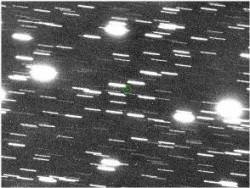Sorry to disappoint those of you hoping for some Martian fireworks the end of this month. NASA’s Near Earth Object (NEO) Program office has effectively ruled out the possibility of Asteroid 2007 WD5 impacting Mars. The probability of such an event has dropped dramatically, to approximately 0.01% or 1 in 10,000 odds of an impact. Observers also say the asteroid has no possibility of impact with either Mars or Earth anytime in the next century.
Recent tracking measurements of the asteroid from several Earth-based observatories have provided a significant reduction in the uncertainties of the asteroid’s position during its close approach to Mars on Jan. 30, 2008. The best estimates now have 2007 WD5 passing about 26,000 km (16,155 miles) from the planet’s center at approximately 12:00 UTC (4:00 am PST) on Jan. 30th. The NEO office at the Jet Propulsion Laboratory has 99.7% confidence that the pass should be no closer than 4000 km (2,485 miles) from Mars’ surface.
The 50 meter (164 feet) wide asteroid was discovered in late November of 2007 by astronomers at the University of Arizona as part of the Catalina Sky Survey. Other telescopes used to track the asteroid are the Kitt Peak telescope in Arizona, the Sloan Digital Sky Survey telescope in New Mexico, New Mexico Tech’s Magdalena Ridge Observatory, the Multi-Mirror Telescope in Arizona, the Mauna Kea telescope in Hawaii and the Calar Alto Observatory in Spain.
An impact on Mars by 2007 WD5 could have created a .8 km (1/2 mile) wide crater on the planet’s surface. Many scientists were excited by the prospect of such an event, one that could possibly be tracked by the many spacecraft orbiting and on the surface of the red planet.
NASA’s Spaceguard Survey continually searches for Near-Earth Asteroids such as 2007 WD5, and their goal is to discover 90% of those larger than 1 km in size. JPL’s NEO office says that goal should be met within the next few years. Each discovered asteroid is continually monitored for the possibility of impact on Earth.
Original News Source: Near Earth Object Program press release


I canceled the assault because I lost the element of surprise.
Next time, I’ll send a big rock from a vector relative to the sun.
Good luck finding that one, earthlings.
‘Tis a shame, but not that unexpected. It would have been a wonderful natural scientific experiment and would have yielded invaluable data on asteroid impacts as well as being a great publicity tool for the need to discover and track as many of these potentially dangerous rocks as possible.
Maybe this was already mentioned so forgive me if you have already been asked this: Does anyone else find it alarming that scientists cannot accurately predict whether or not a space rock of this nature will actually hit or miss the planet Mars? Why was it so difficult to determine its exact path? It seems as if there were hundreds of possible impact locations which i found a little alarming. Again, I do not know or really understand the process of how exactly we track these things but just a thought. 🙂
Actually I find it incredible that we can even see an object that is only 154 feet across from millions of miles away let alone track it closely enough to decide whether or not it will hit a moving target like Mars!
It takes time and several observations of an object moving in space before its trajectory is known well enough to determine where its going to the precision needed. Remember, when viewed from Earth, this tiny object isn’t exactly zipping across the sky. It took some of the largest telescopes in the world to provide the necessary images for the calculations.
What should alarm you is the paltry funding given to finding all the rocks up there that might pose a danger to us in the future. While a civilization-ending collision is highly unlikely any time soon, there are enough rocks the size of this one (the one just missing Mars) floating around out there that the threat of a regionally devastating event is quite real and imminent. The lives of millions of people could be on the line.
With that close of a path isn’t there a possibility of it being trapped in mars obit? Would be kind of interesting to observe the birth of a new moon. And possibility of it colliding with the other moons.
I believe it’s going far too fast to be trapped in Mars orbit. It’s probably going to miss by a considerable distance–far too far away to have any chance of being captured. I’m not even sure that if it missed by a few miles whether it would be going slowly enough to be captured by Mars.
What velocity will the asteroid have after it passes Mars? Could it achieve escape velocity from the solar system?
Glad to learn that Asteroid 2007 WD5 will miss the orange planet Mars in 2008. I wonder how much the current trajectory will perturb the orbit of this asteroid. How close will it come to Earth and Mars on its next time around? Thank you.
Ernie Poani
Taylorville, IL
Eye-inda-Sky (2003)
Fourth Day Gazette (1997)
Fourth Day Presentations (1992)
So glad I stopped at this site as my 10 year old heard of the meteor and was really freaked out about all the possibilities, in response to the lack of information given on the news. Now as she stands over my shoulder looking at the updates, we are not given by the press, and there is once again a smile on her face. Just another example of where to go to find the information you need. Thanks